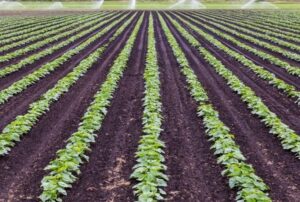How to Grow Healthy Crops with Organic Farming Techniques
Agriculture is the backbone of human civilization, but the growing use of chemical fertilizers and pesticides has had devastating impacts on soil health, biodiversity, and human well-being. Organic and natural farming techniques provide a sustainable solution to these challenges, offering a way to grow healthy crops while preserving the environment. In this blog, we will explore how to implement organic and natural farming methods to cultivate thriving, nutrient-rich crops.
1. Understanding Organic and Natural Farming
Organic farming focuses on cultivating crops without synthetic chemicals, relying instead on natural inputs like compost, manure, and organic pest control methods. Natural farming takes this philosophy further, emphasizing minimal intervention and using techniques that mimic natural ecosystems. Both approaches prioritize soil health, biodiversity, and sustainability.

Key principles include:
- Avoiding synthetic fertilizers and pesticides.
- Encouraging soil fertility through organic matter.
- Using biological pest control methods.
- Promoting crop diversity and rotation.
2. Preparing the Soil for Organic Farming
Healthy soil is the foundation of organic and natural farming. Soil rich in organic matter provides essential nutrients, improves water retention, and promotes the growth of beneficial microorganisms.
Steps to Prepare Soil:
- Test the Soil: Conduct soil tests to determine pH levels and nutrient content. Aim for a pH between 6.0 and 7.5, suitable for most crops.
- Add Organic Matter: Incorporate compost, well-rotted manure, or green manure into the soil. These enhance fertility and improve soil structure.
- Encourage Microbial Activity: Avoid soil sterilization and chemical use that can kill beneficial microbes. Instead, use natural amendments like vermicompost or bio-fertilizers.
- Use Mulch: Cover the soil with organic mulch like straw or grass clippings to retain moisture, suppress weeds, and add nutrients as it decomposes.
3. Choosing the Right Crops
Selecting crops that are well-suited to your local climate, soil type, and market demand is critical. Indigenous or heirloom varieties often perform better in organic systems due to their natural resistance to pests and diseases.
Tips for Crop Selection:
- Focus on crops that grow naturally in your region.
- Mix complementary crops for better pest control and nutrient use.
- Choose disease-resistant and hardy varieties for a higher success rate.
4. Implementing Crop Rotation
Crop rotation is a cornerstone of organic farming that helps maintain soil fertility and prevents pest and disease buildup.
Benefits of Crop Rotation:
- Reduces the risk of soil nutrient depletion.
- Breaks pest and disease cycles.
- Enhances biodiversity in the soil.
Example Rotation Plan:
- Year 1: Plant nitrogen-fixing legumes like beans.
- Year 2: Rotate to heavy feeders like corn or wheat.
- Year 3: Use cover crops or light feeders like lettuce.
5. Natural Pest and Disease Control
Controlling pests and diseases without synthetic chemicals is a hallmark of organic and natural farming. Techniques like integrated pest management (IPM) ensure a balanced approach to crop protection.
Strategies for Natural Pest Control:
- Encourage Beneficial Insects: Attract predators like ladybugs and praying mantises by planting flowers like marigold and dill.
- Use Organic Sprays: Apply neem oil, garlic spray, or soap solutions to deter pests.
- Crop Diversification: Intercrop with pest-repellent plants, such as growing garlic with tomatoes to keep aphids away.
- Trap Crops: Plant sacrificial crops that pests prefer to protect your main crops.
6. Water Management in Organic Farming
Efficient water use is vital for organic farming. Overwatering can lead to nutrient leaching, while under-watering stresses plants, reducing yields.
Water-Saving Techniques:
- Drip Irrigation: Delivers water directly to the plant roots, reducing wastage.
- Rainwater Harvesting: Collect and store rainwater for irrigation.
- Mulching: Retains soil moisture and reduces evaporation.
- Timing: Water early in the morning or late afternoon to minimize evaporation.
7. Enhancing Soil Fertility Naturally
Maintaining soil fertility without chemical inputs requires a combination of techniques to ensure crops receive essential nutrients.
Natural Fertilizers and Soil Amendments:
- Compost: Adds organic matter and nutrients while improving soil structure.
- Green Manures: Grow cover crops like clover or alfalfa, then till them into the soil as a natural fertilizer.
- Bone Meal and Rock Phosphate: Provide phosphorus for root development.
- Wood Ash: Supplies potassium for overall plant health.
8. Weed Management in Organic Farming
Weeds compete with crops for nutrients, light, and water. Organic weed management involves preventing weed growth and removing them effectively.
Methods for Controlling Weeds:
- Mulching: Suppresses weed growth and maintains soil moisture.
- Crop Rotation: Breaks weed cycles by alternating crops with different growth habits.
- Manual Weeding: Hand-pulling or using simple tools to remove weeds.
- Flame Weeding: Using controlled heat to destroy weed seedlings in larger fields.
9. Harvesting and Post-Harvest Practices
Timely harvesting ensures maximum yield and quality while minimizing losses. Organic farmers should also handle crops with care to retain their freshness and nutrient content.
Harvesting Tips:
- Harvest crops during the cooler parts of the day.
- Use clean, sharp tools to avoid damage to plants.
- Sort and pack produce immediately to maintain freshness.
Post-Harvest Handling:
- Wash crops with clean water to remove dirt and residues.
- Store in a cool, dry place to extend shelf life.
- Use biodegradable packaging to align with eco-friendly practices.
10. Benefits of Organic and Natural Farming
Growing crops using organic and natural farming techniques offers multiple benefits:
- Healthier Produce: Free from harmful chemicals, organic crops are safer and more nutritious.
- Environmental Protection: Promotes biodiversity, reduces pollution, and enhances soil health.
- Cost-Effective: Saves money on synthetic inputs over time.
- Consumer Demand: Organic produce fetches premium prices in the market.
Final Thoughts
Transitioning to organic and natural farming requires dedication, but the rewards are immense. By focusing on soil health, pest management, and sustainable practices, farmers can grow healthy crops that benefit both people and the planet. Start small, experiment with different techniques, and adapt to your local conditions to achieve success.
In a world increasingly conscious of the environment and food quality, organic and natural farming is more than a choice—it’s a necessity for a sustainable future.














1 comment